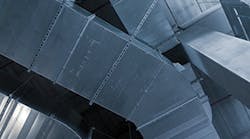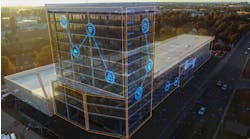A fire starts in your building – an alarm sounds, fire doors activate, and occupants rush outside to safety. But what about your HVAC system?
"In an emergency, air duct systems can transfer smoke, toxic gases, and flame from one area to another, posing a serious hazard to life safety and property," explains Jim Kapparos, national sales manager for System Sensor, a manufacturer of fire alarm systems.
Take the infamous 1980 MGM Grand fire. While the fire was contained to the lower levels of the casino, most of the 85 deaths occurred on the upper floors from smoke inhalation and carbon monoxide poisoning. Faulty dampers accelerated the spread of dangerous fumes to stairwells and emergency passageways.
According to the official investigation report by NFPA, "the distribution of smoke throughout the high-rise tower through the heating, ventilation, and air equipment" was a major factor contributing to the death toll.
To safeguard your ductwork from becoming a pathway for fire, make sure your facility is protected by duct smoke detectors.
How Do They Work?
Duct detectors sample currents in the air handling equipment to determine if smoke or fumes are present. If smoke is detected, the device will close dampers, stop fans and blowers, and trigger an audible and visible signal at the fire control panel, Kapparos explains.
These actions provide early detection, allow facility personnel to investigate the cause, and can protect the air conditioning system itself from fire and smoke damage.
Typically found in large commercial and industrial facilities, duct smoke detectors are a code-mandated device where required by NFPA 72 (90A), NFPA 101, and the International Mechanical Code (IMC), says Kapparos.
Stipulations can also be found in the International Building Code, International Fire Code, and the Life Safety Code 101, adds Bernie Arends, who served as an origin and cause fire investigator for over 30 years and works as a sales associate for Inspection Reports Online.
While local code adoption varies, duct smoke detectors are most common for facilities with 5-ton or more cooling units.
"Duct smoke detectors are needed on HVAC units over 2000 cfm on the return side, and on units over 15,000 cfm on the supply and return sides," says Arends.
Some can also be interconnected to other duct detectors. If one senses smoke, the rest will switch their relays, with the triggered detector reporting to the fire alarm panel so the source can be pinpointed. PageBreak
Maintenance Requirements
Like any other fire safety components, duct detectors need routine upkeep and testing to remain effective.
Dust, dirt, and other foreign matter can accumulate inside a detector and change its sensitivity, which may cause unwanted alarms or reduce the level of protection, Kapparos says.
"The installing contractors must provide the owner with cut sheets for these critical life safety devices," notes Arends. "Preventive maintenance and servicing information is specific to each manufacturer and should be strictly adhered to."
At minimum, Kapparos suggests these regular measures:
- Visually inspect detectors every six months to confirm that they are in a normal operating state.
- Test annually by causing units to initiate an alarm at their installed location, ensuring they produce the intended response.
- Check within one year after installation and every alternate year thereafter to assure devices are within their listed and marked sensitivity range.
- Test or inspect annually to ensure detectors sample the air stream.
Because the units are often hard to reach, remote test/reset switches that are easy to see and access should be installed within close proximity of the unit, says Ahrends.
Most sensors use LEDs to indicate if the device is operating outside its preset sensitivity range. To check the detectors, differential pressure testing can be used, though some jurisdictions require smoke bombs.
If you find that a sensor requires cleaning, use a vacuum cleaner, compressed air, or dry nitrogen to remove dust and debris, recommends Kapparos.
Big Benefits, Little Costs
Duct smoke detectors are modestly priced, ranging from $125 to several hundred dollars, estimates Arends. If you don't currently have any, they are easy to retrofit. Changes in design, use, or occupancy may warrant additional devices as the building ages.
"When you consider the code requirement as well as the possible liability ramifications if an event were to occur in a building with non-maintained or non-working devices, the cost is overall minimal," states Kapparos.
Keep in mind that a duct detector only works within the HVAC system – it is not a substitute for fire detection or early warning devices in open building areas.
Duct smoke detectors are yet another way savvy facility managers can extend fire protection. To learn more about building and occupant safety, read A New Era of Life Safety.
Jennie Morton [email protected] is associate editor of BUILDINGS.


